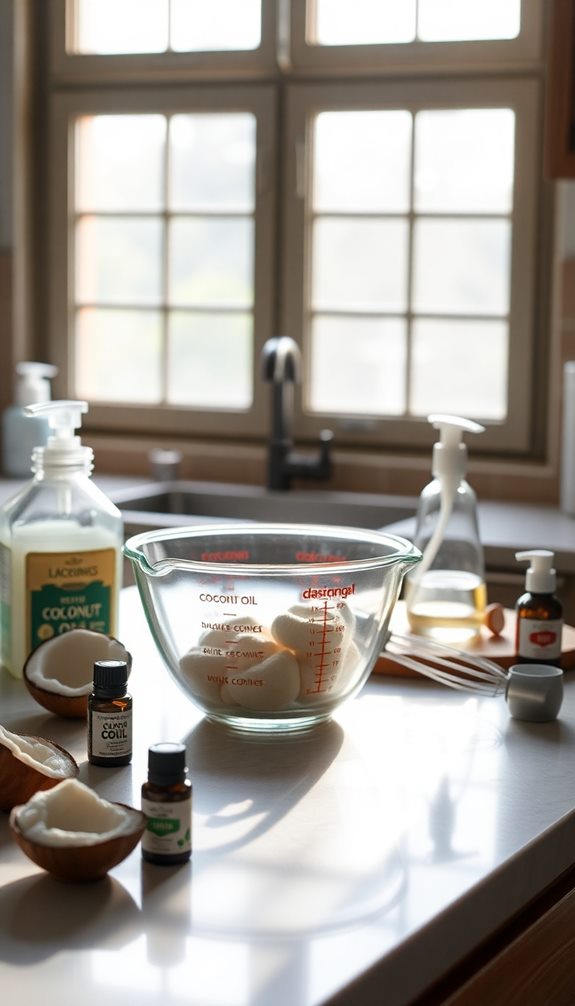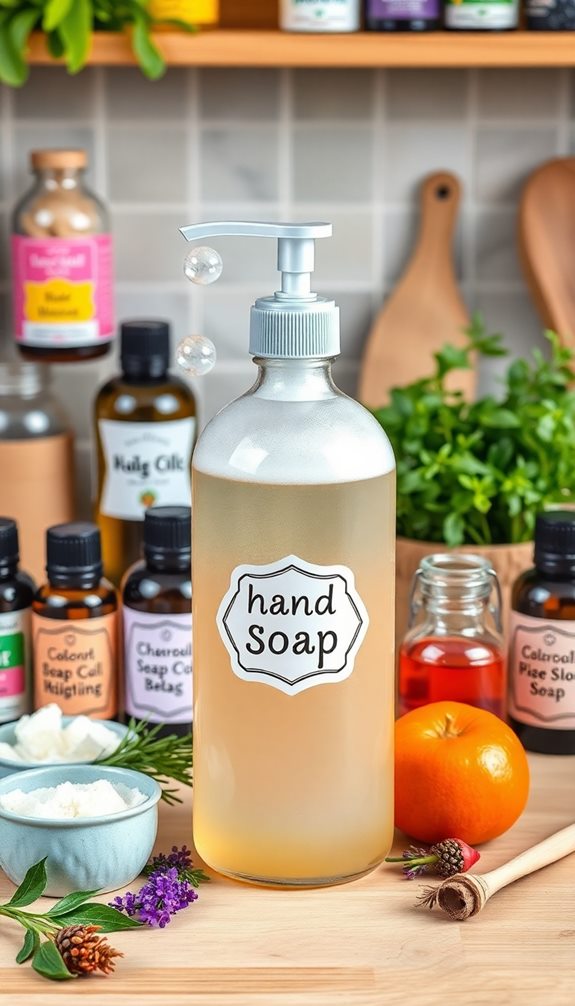You can easily whip up a chemical-free foaming hand soap at home using just a few simple ingredients. Start with 3 tablespoons of unscented liquid Castile soap, add 10-15 drops of your favorite essential oil for fragrance, and mix it with 1 cup of distilled water in a clean foaming soap dispenser. Secure the lid and swirl gently to combine. This cost-effective recipe not only avoids harsh chemicals, but it's also customizable and eco-friendly. If you're curious about choosing the right dispenser or enhancing your soap even further, there are plenty of tips to explore!
Benefits of DIY Foaming Soap
Have you ever wondered why so many people are switching to DIY foaming hand soap? The benefits are hard to ignore.
First off, it's incredibly cost-effective. By using simple ingredients like Castile soap and water, you'll save money compared to buying store-bought natural soaps. Plus, making your own soap gives you complete control over what goes in it. You can easily avoid harsh chemicals and synthetic additives that often lurk in commercial products, ensuring a healthier environment for you and your family.
Additionally, opting for this homemade solution aligns with the growing demand for eco-friendly cleaning products that prioritize sustainability and safety.
Customization is another major perk. You can personalize your soap with your favorite essential oils, allowing you to create unique scents and even add moisturizing properties tailored to your skin's needs. This means you can enjoy a chemical-free cleansing experience that suits your individual preferences.
An eco-friendly approach also comes into play. By using reusable dispensers, you're actively reducing plastic waste and promoting sustainability in your daily routine.
Essential Ingredients for the Recipe
To create your DIY foaming hand soap, you'll need a few essential ingredients that make all the difference.
You'll start with unscented liquid Castile soap as the base, which is a gentle and effective option free from harsh chemicals.
You can enhance your soap with optional essential oils for fragrance and benefits, such as tea tree or lavender, known for their antibacterial properties and natural cleaning benefits.
Selecting high-quality supplies guarantees your soap is effective and gentle on your skin.
Key Ingredients Overview
When creating your own foaming hand soap, the key ingredients play an essential role in ensuring both effectiveness and skin-friendliness. The foundation of your homemade foaming hand soap is liquid Castile soap, which is gentle, biodegradable, and often unscented.
For the best results, mix one part Castile soap with four parts distilled water. This ratio provides an effective lather while keeping the formula light.
To enhance your soap, consider adding essential oils for fragrance and additional benefits. Choose oils like lemon, known for its antibacterial properties, or lavender for a calming effect. A small amount of carrier oil, such as almond or jojoba, can also boost moisture on your skin.
Remember, using distilled water is vital for purity, as it keeps your soap free from impurities that may affect its performance.
Here's a quick overview of the essential ingredients:
- Liquid Castile soap
- Distilled water
- Essential oils (like lemon or lavender)
- Carrier oil (almond or jojoba)
- Foaming hand soap dispenser
These ingredients will help you create a delightful and effective foaming hand soap.
Essential Oil Options
Essential oils are a fantastic way to elevate your DIY foaming hand soap, infusing it with delightful scents and added benefits. Not only do these essential oils provide pleasant fragrances, but they also enhance the effectiveness of your hand soap by offering antibacterial and antiviral properties.
For your recipe, consider using lemon essential oil for its cleansing qualities, which pairs beautifully with pure Castile soap. Lavender is another great option; it lends a calming effect that can transform your handwashing experience. If you're looking for something with strong purifying characteristics, tea tree oil is a solid choice.
When adding essential oils, aim for 10-15 drops per recipe. This allows you to customize your foaming hand soap based on your scent preferences and sensitivities. It's vital, however, to select your essential oils from high-quality sources. Confirm they're pure and free from synthetic additives or fragrances to maintain the health benefits.
Choosing Quality Supplies
Selecting quality supplies is key to making your DIY foaming hand soap effective and enjoyable. Start with unscented liquid Castile soap as your base. It's gentle, biodegradable, and free from harsh chemicals, making it the perfect choice for your skin.
Next, use distilled water to guarantee purity and avoid any impurities that could affect the soap's performance.
When it comes to fragrance, high-quality essential oils, like lemon or lavender, can enhance both the scent and antibacterial properties of your soap. Aim for 10-15 drops for the best results.
Don't forget a foaming soap dispenser, which is crucial for achieving that lovely foam consistency. If you're using citrus essential oils, opt for a glass dispenser to prevent degradation of plastic.
Lastly, consider adding a carrier oil, such as almond or jojoba oil, to boost the moisturizing properties of your hand soap. This addition is especially beneficial for sensitive skin.
Here's a quick list of what you need:
- Unscented liquid Castile soap
- Distilled water
- High-quality essential oils
- Foaming soap dispenser
- Carrier oil (like almond or jojoba)
Step-by-Step Preparation Instructions

Making your own foaming hand soap is a simple and satisfying project that requires just a few ingredients.
To start your foaming hand soap recipe, grab a clean foaming soap dispenser. Begin by adding 3 tablespoons of liquid Castile soap into the dispenser. This soap provides excellent cleansing properties and is reminiscent of eco-friendly cleaning options like Seventh Generation All-Purpose Cleaner.
Next, incorporate 10-15 drops of your favorite essential oils to customize the fragrance. Feel free to adjust this amount based on your sensitivity to scents.
Then, pour 1 cup (8 oz) of distilled water into the dispenser. Be certain to leave some space at the top for mixing the ingredients.
After that, secure the lid on the dispenser and gently swirl the mixture to combine everything without creating bubbles. This step guarantees that the liquid Castile soap blends well with the water and essential oils.
Choosing the Right Dispenser
When you're picking a foaming hand soap dispenser, consider the material and pump type to get the best results.
Glass dispensers work well with essential oils, while plastic might degrade over time.
Also, think about whether you want a manual pump or a touchless option based on your space and usage needs.
Dispenser Material Considerations
Choosing the right dispenser for your DIY foaming hand soap involves several important considerations. The material you select can impact both the effectiveness and safety of your soap. Here are some key points to keep in mind:
- Glass: Ideal for citrus essential oils, as it prevents degradation from acidic compounds.
- Plastic: Lightweight and durable, but it may leach chemicals over time, particularly with strong essential oils.
- Foaming Soap Compatibility: Confirm the dispenser is specifically designed for foaming soap, as traditional pumps mightn't create the lather you want.
- Reusable: Opt for a reusable dispenser to promote sustainability and reduce plastic waste; this allows you to refill it multiple times.
- Ease of Cleaning: Choose a dispenser that's easy to clean and refill, encouraging regular maintenance of your DIY soap mixture.
Pump Type Selection
After evaluating the material and overall design of your dispenser, it's time to focus on the pump type. When selecting a foaming hand soap container, make sure it's specifically designed for foaming soap. This will help you achieve that perfect lather and consistency you want.
Look for a pump mechanism that allows for easy and controlled dispensing, minimizing waste while guaranteeing you get just the right amount of soap.
If you're using citrus oils, opt for a glass dispenser. Glass prevents degradation and chemical leaching that often occurs with plastic, keeping your soap pure and effective.
For limited spaces, wall-mounted dispensers are an excellent choice, while traditional pump dispensers offer flexibility and ease of use wherever you need them.
Don't forget to take sustainability into account in your selection. Choosing reusable dispensers not only helps reduce environmental impact but also allows you to refill them multiple times, saving you money in the long run.
With the right pump type, your DIY foaming hand soap will be both practical and eco-friendly!
Customizing Your Soap

Customizing your foaming hand soap allows you to create a product that suits your personal preferences and skin needs. Start by selecting your favorite essential oils; add 10-15 drops for a scent that invigorates or calms. For example, lavender promotes relaxation, while lemon offers a revitalizing aroma.
Additionally, opting for eco-friendly ingredients can enhance your product's sustainability, similar to how eco-friendly wipes contribute to a greener lifestyle. You can also experiment with the ratio of castile soap to water. The standard is 1 part soap to 3 parts water, but feel free to adjust for a thicker or thinner consistency.
To enhance the moisturizing properties of your soap, consider incorporating about 1 teaspoon of liquid oil, like jojoba or almond.
Here are some tips to elevate your natural foaming hand soap:
- Choose unscented castile soap as a base for total control over the fragrance.
- Explore essential oils with additional benefits, like tea tree oil for its cleansing properties.
- Mix and match scents to create a unique blend.
- Test different ratios until you find your ideal consistency.
- Keep track of your custom recipes for future batches.
With these simple adjustments, you'll have a personalized soap that caters to your skin's needs and preferences!
Community Feedback and Sharing
The vibrant community around DIY foaming hand soap is a treasure trove of ideas and experiences. You'll find countless users sharing their unique modifications, showcasing the versatility of ingredients like essential oils for personalized scents.
This community feedback highlights how effective and easy it's to make your own hand soap, contributing to a healthier workplace with eco-friendly practices. Many users express satisfaction with the delightful foaming action and moisturizing properties of their creations.
Common discussions include preferences for dispensers, where some advocate for glass to avoid interactions with essential oils, while others prefer plastic for practicality.
You'll notice a strong emphasis on the chemical-free nature of the recipe, with many contributors grateful for its safety, especially for sensitive skin and families.
The comments section acts as a hub for support, where users not only share their successes but also request additional recipes. This fosters a welcoming atmosphere focused on natural living and eco-friendly practices.
Conclusion
Now that you've got the recipe and tips in hand, it's time to roll up your sleeves and create your own foaming hand soap. Not only will you enjoy a chemical-free clean, but you'll also save money and customize scents to your liking. So, don't just sit on the fence—dive in and start crafting your soap today! Your hands will thank you, and you'll feel great knowing you made it yourself.